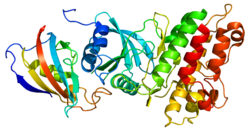ACVR1
ACVR1Activin A 수용체, 타입 I(ACVR1)은 인간에서 ACVR1 유전자에 의해 인코딩되는 단백질로, ALK-2(수용체 유사 키나제-2 활성화)라고도 한다.[5]ACVR1은 게놈의 2분기 23-24 영역과 연결되어 있다.[6]이 단백질은 골격계의 발달과 수리를 담당하는 골격형 단백질(BMP) 경로에서 중요하다.이 유전자를 가진 녹아웃 모델이 진행 중인 가운데 ACVR1 유전자는 체내에 이질성 뼈가 형성되는 특징이 있는 질환인 섬유로디플라스시아 오시픽스와 연결됐다.[6]그것은 뼈 형태생성 단백질 수용체, 타입 1이다.
함수
활성은 구조적으로 관련된 신호 단백질의 변형 성장 인자-베타(TGF 베타) 슈퍼 패밀리에 속하는 조광성 성장과 분화 요인이다.활성인은 적어도 2개의 타입 I(I 및 IB) 수용체와 2개의 타입 II(II 및 IIB) 수용체를 포함하는 수용체 세린 키나제의 이질적 복합체를 통해 신호를 보낸다.이 수용체들은 모두 투과성 단백질로, 시스테인이 풍부한 부위의 리간드 결합 세포외 영역, 투과성 영역, 세린/스로닌 특이성이 예측된 세포질 영역으로 구성되어 있다.1형 수용체는 신호 전달에 필수적이며, 2형 수용체는 리간드를 결합하고 1형 수용체를 표현하는데 필요하다.Ⅰ형과 Ⅱ형 수용체는 리간드 결합 후 안정된 콤플렉스를 형성하여 Ⅱ형 수용체별로 Ⅰ형 수용체가 인산화되는 결과를 초래한다.이 유전자는 activin Ⅰ형 수용체를 인코딩하여 activin Ⅱ형 수용체와 함께 특정한 전사 반응을 신호한다.[7]
신호
ACVR1은 BMP의 신호를 변환한다. BMP는 ACVR2A/ACVR2B 또는 BMPR2 중 하나를 결합한 다음, ACVR1로 콤플렉스를 형성한다.R-SMADs SMAD1, SMAD2, SMAD3 또는 SMAD6를 모집한다.[8]
임상적 유의성
유전자 ACVR1/ALK2의 기능상 돌연변이는 진행 중인 유전병의 원인이 된다.[9]일반적인 FOP 환자는 이 단백질의 위치 206에서 아미노산 히스티딘 대신 아미노산 아르기닌을 사용한다.[10][11]이로 인해 단백질의 중요 글리신-세린 활성화 영역이 변경되어 단백질이 억제 리간드(FKBP12)를 덜 단단하게 묶게 되고, 따라서 BMP/SMAD 경로를 과도하게 활성화하게 된다.[6]이 과잉활성화의 결과는 내피세포가 중피줄기세포로 바뀐 다음 뼈로 바뀐다는 것이다.[12]다른 잔류물과 관련된 비정형 돌연변이도 유사하게 작용하여 BMP가 없음에도[13] 불구하고 단백질이 능동적 순응에 원인이 있음
ACVR1 유전자의 돌연변이는 또한 암, 특히 확산성 폰틴 교모종(DIPG)과 연관되어 있다.[14][15][16]
참조
- ^ a b c GRCh38: 앙상블 릴리스 89: ENSG00000115170 - 앙상블, 2017년 5월
- ^ a b c GRCm38: 앙상블 릴리스 89: ENSMUSG000026836 - 앙상블, 2017년 5월
- ^ "Human PubMed Reference:". National Center for Biotechnology Information, U.S. National Library of Medicine.
- ^ "Mouse PubMed Reference:". National Center for Biotechnology Information, U.S. National Library of Medicine.
- ^ ten Dijke P, Ichijo H, Franzén P, Schulz P, Saras J, Toyoshima H, Heldin CH, Miyazono K (October 1993). "Activin receptor-like kinases: a novel subclass of cell-surface receptors with predicted serine/threonine kinase activity". Oncogene. 8 (10): 2879–87. PMID 8397373.
- ^ a b c Pignolo, Robert J. (June 2013). "Fibrodysplasia Ossificans Progressiva: Diagnosis, Management, and Therapeutic Horizons". Pediatr Endocrinol Rev. 10 Suppl 2: 437–48. PMC 3995352. PMID 23858627.
- ^ "Entrez Gene: ACVR1 (activin A receptor, type I)".
- ^ Inman GJ, Nicolás FJ, Callahan JF, Harling JD, Gaster LM, Reith AD, Laping NJ, Hill CS (July 2002). "SB-431542 is a potent and specific inhibitor of transforming growth factor-beta superfamily type I activin receptor-like kinase (ALK) receptors ALK4, ALK5, and ALK7". Molecular Pharmacology. 62 (1): 65–74. doi:10.1124/mol.62.1.65. PMID 12065756.
- ^ Shore EM, Xu M, Feldman GJ, Fenstermacher DA, Cho TJ, Choi IH, Connor JM, Delai P, Glaser DL, LeMerrer M, Morhart R, Rogers JG, Smith R, Triffitt JT, Urtizberea JA, Zasloff M, Brown MA, Kaplan FS (May 2006). "A recurrent mutation in the BMP type I receptor ACVR1 causes inherited and sporadic fibrodysplasia ossificans progressiva". Nature Genetics. 38 (5): 525–7. doi:10.1038/ng1783. PMID 16642017. S2CID 41579747.
- ^ Shore, Eileen M.; Xu, Meiqi; Feldman, George J.; Fenstermacher, David A.; Cho, Tae-Joon; Choi, In Ho; Connor, J. Michael; Delai, Patricia; Glaser, David L.; LeMerrer, Martine; Morhart, Rolf (May 2006). "A recurrent mutation in the BMP type I receptor ACVR1 causes inherited and sporadic fibrodysplasia ossificans progressiva". Nature Genetics. 38 (5): 525–527. doi:10.1038/ng1783. ISSN 1546-1718. PMID 16642017. S2CID 41579747.
- ^ "News Release of FOP's Cause". Archived from the original on 2012-01-13. Retrieved 2012-02-29.
- ^ van Dinther M, Visser N, de Gorter DJ, Doorn J, Goumans MJ, de Boer J, ten Dijke P (June 2010). "ALK2 R206H mutation linked to fibrodysplasia ossificans progressiva confers constitutive activity to the BMP type I receptor and sensitizes mesenchymal cells to BMP-induced osteoblast differentiation and bone formation". Journal of Bone and Mineral Research. 25 (6): 1208–15. doi:10.1359/jbmr.091110. PMID 19929436. S2CID 207269687.
- ^ Petrie, KA; Lee, WH; Bullock, AN; Pointon, JJ; Smith, R; Russell, RG; Brown, MA; Wordsworth, BP; Triffitt, JT (2009). "Novel mutations in ACVR1 result in atypical features in two fibrodysplasia ossificans progressiva patients". PLOS ONE. 4 (3): e5005. Bibcode:2009PLoSO...4.5005P. doi:10.1371/journal.pone.0005005. PMC 2658887. PMID 19330033.
- ^ Taylor KR, Mackay A, Truffaux N, Butterfield YS, Morozova O, Philippe C, Castel D, Grasso CS, Vinci M, Carvalho D, Carcaboso AM, de Torres C, Cruz O, Mora J, Entz-Werle N, Ingram WJ, Monje M, Hargrave D, Bullock AN, Puget S, Yip S, Jones C, Grill J (May 2014). "Recurrent activating ACVR1 mutations in diffuse intrinsic pontine glioma". Nature Genetics. 46 (5): 457–61. doi:10.1038/ng.2925. PMC 4018681. PMID 24705252.
- ^ "Cure Brain Cancer - News - Multiple Breakthroughs in Childhood Brain Cancer DIPG". Cure Brain Cancer Foundation.
- ^ Buczkowicz P, Hoeman C, Rakopoulos P, Pajovic S, Letourneau L, Dzamba M, et al. (May 2014). "Genomic analysis of diffuse intrinsic pontine gliomas identifies three molecular subgroups and recurrent activating ACVR1 mutations". Nature Genetics. 46 (5): 451–6. doi:10.1038/ng.2936. PMC 3997489. PMID 24705254.
외부 링크
- UCSC 게놈 브라우저의 인간 ACVR1 게놈 위치 및 ACVR1 유전자 세부 정보 페이지.
- PDBe-KB에서 UniProt: Q04771(Human Activin receptor-1)에 대한 PDB에서 사용할 수 있는 모든 구조 정보의 개요.
이 기사는 공공영역에 있는 미국 국립 의학 도서관의 텍스트를 통합하고 있다.





